If you're looking for podcasting equipment, chances are you have an idea to share with the world. The beauty of podcasts is that there are no rules, just a simple connection between the host, guests (if applicable) and listener.
To create that connection, you need the right gear.
Some podcasters can get started with a USB microphone and studio headphones. More ambitious plans might require a home studio with broadcast mics, an audio interface and acoustic treatment. If you're looking for the easiest solution, podcasting kits will have you recording in minutes.
Your podcast setup should make the recording process effortless. It should remove the barriers between you and your audience so you can focus on what matters most. In this guide, we’ll help you find the best gear to fit your podcasting needs.
Table of Contents
The Best Podcasting Gear
USB Microphones
Analog Microphones
Audio Interfaces
Mixers
Podcast Bundles
Headphones
Digital Audio Workstation (DAW) Software
Accessories
And We're Live
People Also Ask ...
The Best Podcasting Gear
USB Microphones
If you want to make podcasts on your computer with as little extra hassle as possible, USB mics are an excellent choice. These mics are digital, meaning they take your speech and turn it into a signal that goes directly into your computer. While not quite at the level of the industry-standard broadcast mics we'll go over next, a USB mic with a relatively flat frequency response, low self-noise and consistent polar pattern can still work great for podcast use. It also eliminates the need for extra gear like mic preamps and audio interfaces.
Audio-Technica AT2020USB-X
Why We Chose It: Like its analog AT2020 counterpart, this version captures all the full-spectrum nuances condenser mics are known to capture, plus the convenience of a direct USB connection.
Key Features:
- While slightly pricier than the original, the USB-equipped version has some handy workflow enhancing features, such as onboard gain and level wheels
- Headphone jack allows you to monitor sound directly from the mic with virtually zero latency
- 24-bit/96kHz A/D (audio to digital) converter yields stunning depth and detail
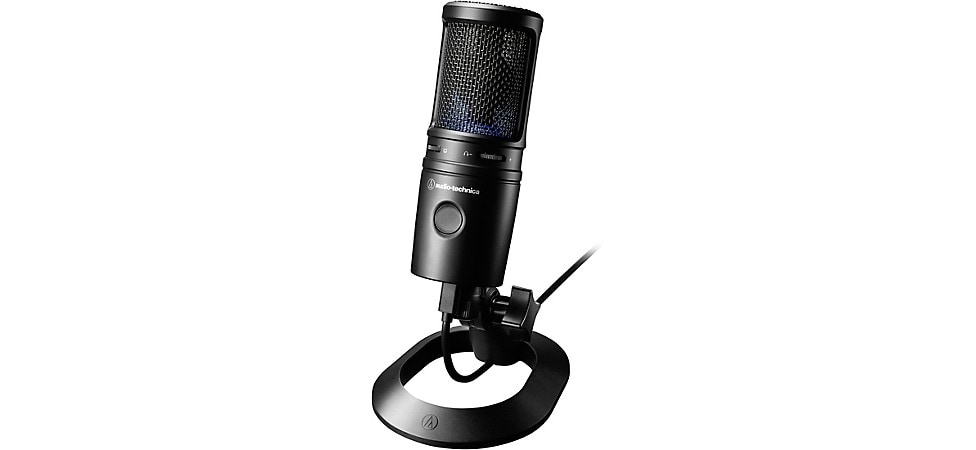
Shop Now: Audio-Technica AT2020USB-X Cardioid Condenser USB Microphone
The Audio-Technica AT2020USB-X USB microphone’s cardioid polar pattern focuses on the sound directly in front of it, rejecting off-axis sound—mitigating any unwanted noise from your surroundings. Not only does it feature a clever built-in headphone output, but its soft-touch capacitive mute button gives you quick, easy access to controls you’d otherwise be reaching for on an interface or DAW.
Apogee HypeMiC USB
Why We Chose It: Built in the USA, this condenser hits the sweet spot at the intersection of affordability and build quality.
Key Features:
- Package includes a carrying case, tripod, pop screen and various USB cables to get you set up
- Three onboard compression settings get you closer to a “broadcast-ready” mix at the source
- 24-bit/96kHz A/D (audio to digital) converter yields stunning depth and detail
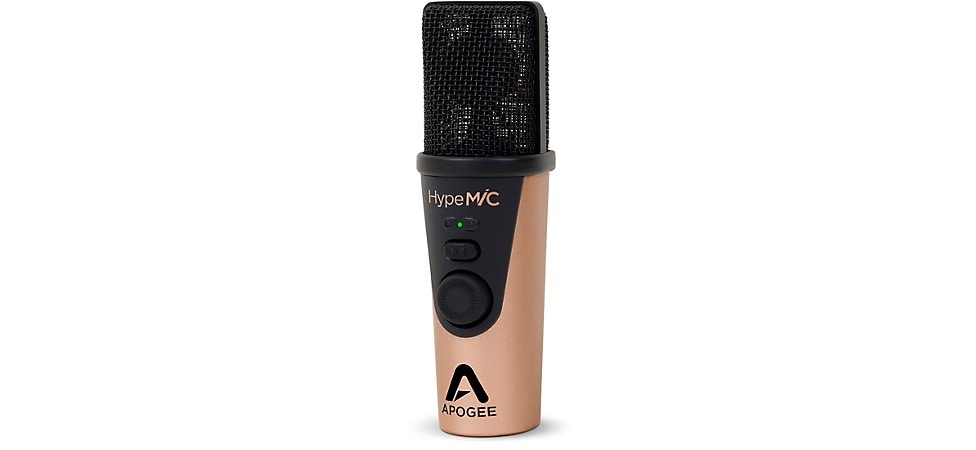
Shop Now: Apogee HypeMiC USB Microphone
By their own admission, Apogee had podcasters in mind when they designed the HypeMiC USB condenser mic. Its onboard features don’t peter out at headphone level and mic gain controls—it’s also got a compressor that gives you audio engineer-curated settings that smooth out your dynamics at the press of a button. That means less editing and more focus on creating your content.
Analog Microphones
Audio-Technica AT2040
Why We Chose It: Perfect for podcasters with a less-than-ideal acoustic space, this surprisingly affordable mic is one of our top all-around picks for content creation.
Key Features:
- Hypercardioid polar pattern tightly focuses on what’s in front of the capsule, which means less room noise
- Multistage internal windscreen gives you superior pop protection
- XLR-equipped mic—you’ll need an audio interface with a mic pre
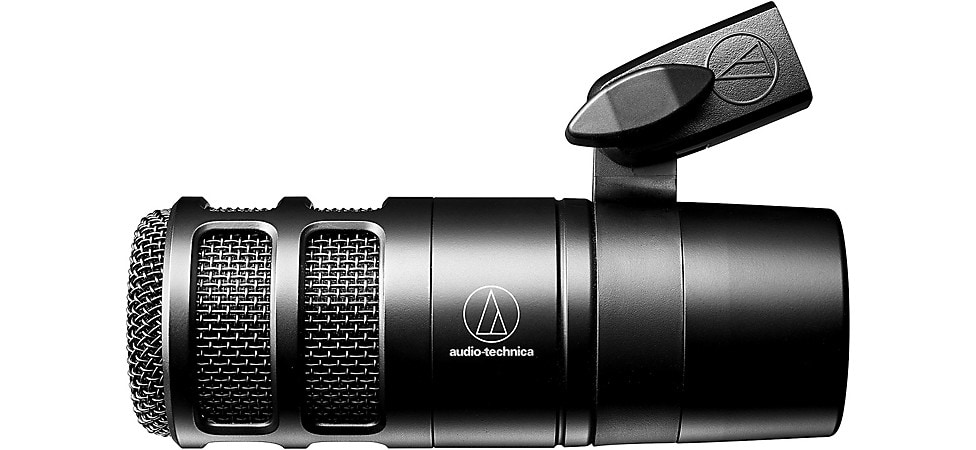
Shop Now: Audio-Technica AT2040 Dynamic Podcast Microphone
The Audio-Technica AT2040 takes a page from the best-selling BP40 broadcast mic with its front-address, large-diaphragm dynamic design and condenser-like sound that flatters your voice. And its integrated shockmount system minimizes any vibrations and handling noise, which is a huge benefit no matter what mic stand you’re using.
Shure SM58
Why We Chose It: Perhaps the most affordable, jack-of-all-trades professional choice is the SM58 cardioid dynamic, one of the best-selling vocal mics in the world
Key Features:
- Frequency response is tailored for vocals, cutting out low-end rumble and harsh high end from the get-go
- Internal pneumatic shockmount minimizes handling noise
- Break-resistant stand adapter rotates 180 degrees
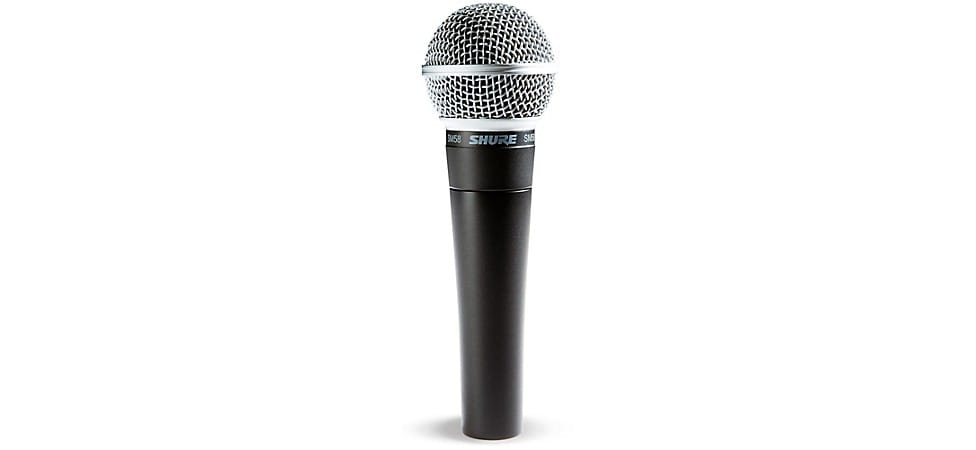
Shop Now: Shure SM58 Dynamic Microphone
Knowingly or not, the Shure SM58 is a mic you’ve definitely seen and heard. Thanks to its cardioid polar pattern, naturally picks up only the sounds it receives head on, snubbing background noise at the source—making it one of the most-used live vocal mics. Plus, it’s extremely durable and easy to find at your nearest Guitar Center.
Shure SM7dB
Why We Chose It: A revamp of the storied SM7B, the ever-versatile SM7dB adds a built-in preamp, making it arguably the pro podcasting mic
Key Features:
- Frequency response is tailored for vocals, cutting out low-end rumble and harsh high end from the get-go
- Internal pneumatic shockmount minimizes handling noise
- Break-resistant stand adapter rotates 180 degrees

Shop Now: Shure SM7dB Dynamic Vocal Microphone
For a more specialized option, Shure also makes the SM7dB, which delivers all of the benefits of the perennially best-selling yet low-output SM7B, but with a built-in, switchable preamp that offers 18dB or 28dB of clean gain. On the more budget-friendly side, designed specifically with podcasters in mind, Shure's MV7+ offers onboard DSP capabilities, LED audio level metering, and both XLR and USB-C connectivity.
Electro-Voice RE20
Why We Chose It: Traditionally a broadcast announcer’s mic for its smooth and controlled sonic signature, the legendary Electro-Voice RE20 also very much looks the part.
Key Features:
- Variable-D technology mitigates the proximity effect, a phenomenon where the closer you get the mic, the more it picks up the lower frequencies
- Frequency response is ideal for spoken word
- Mid-bass tone-shaping switch helps you sculpt your sound at the start of your signal chain
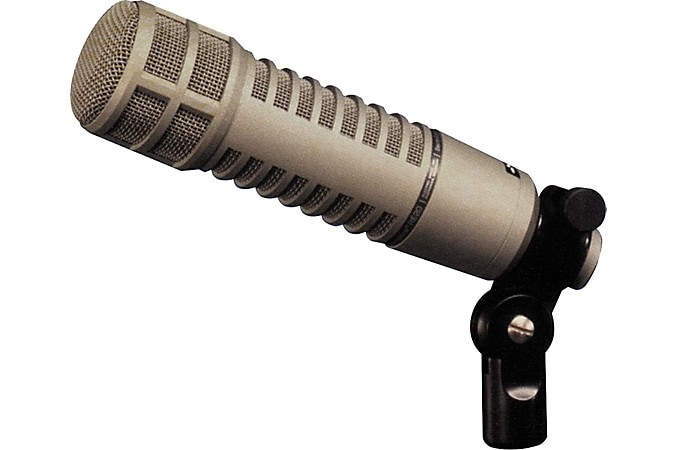
Shop Now: Electro-Voice RE20 Dynamic Microphone
EV released the RE20 dynamic mic in 1968, and it was such a hit that it’s remained largely unchanged since. Much like the SM7B and SM58, the RE20 has a built-in pop filter and internal shockmount, which helps make sure your voice is the only sound being recorded. This is an industry-standard mic that will have you sounding like a pro with its warm analog sound.
AKG C414
Why We Chose It: Traditionally a broadcast announcer’s mic for its smooth and controlled sonic signature, the legendary Electro-Voice RE20 also very much looks the part.
Key Features:
- Higher-end mic with an appropriately loftier price
- Ideal if you have a well acoustically treated space—with little to no echo and ambient noise
- Two variants currently in production: the XLS and XLII
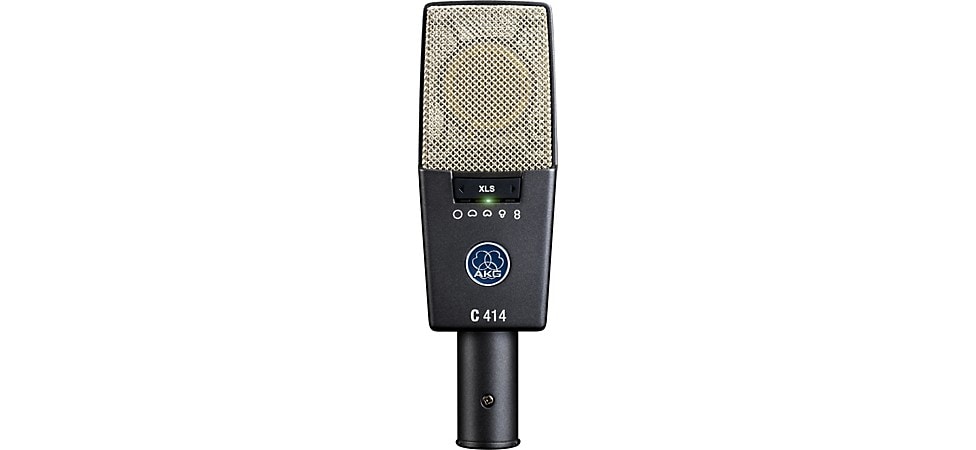
Shop Now: AKG C414 XLS Reference Multi-Pattern Condenser Microphone
A more lavish selection is the European-made AKG C414, an iconic condenser microphone series used on thousands of hit records. The C414 is a multi-pattern mic, with selectable polar patterns and other settings to customize your sound. It’s great for podcasting, but is also a powerful mic for capturing acoustic instruments and ambient sounds. The key difference between the two presently available models, the XLS and XLII, is the capsule. The XLS sounds more transparent. It's best for capturing super-accurate sound. The XLII adds a little more color and is very flattering for voice applications.
Smartphone Microphones
For podcasters who want to record on the go, there are handy, highly capable digital mics that plug directly into your smartphone. These mics are unrivaled in portability, and thanks to recent advancements like app compatibility, they can sound great, too.
Shure MV88+ Stereo USB
Why We Chose It: Cunningly compact and immensely versatile, the MV88+ is a wise choice whether you’re running a stationary setup or a field recording rig.
Key Features:
- Can record in mono or stereo
- Condenser mic picks up plenty of sonic nuance
- Via the MOTIV app, you can select from various pickup patterns to suit your recording environment, and set gain, compression, EQ and more
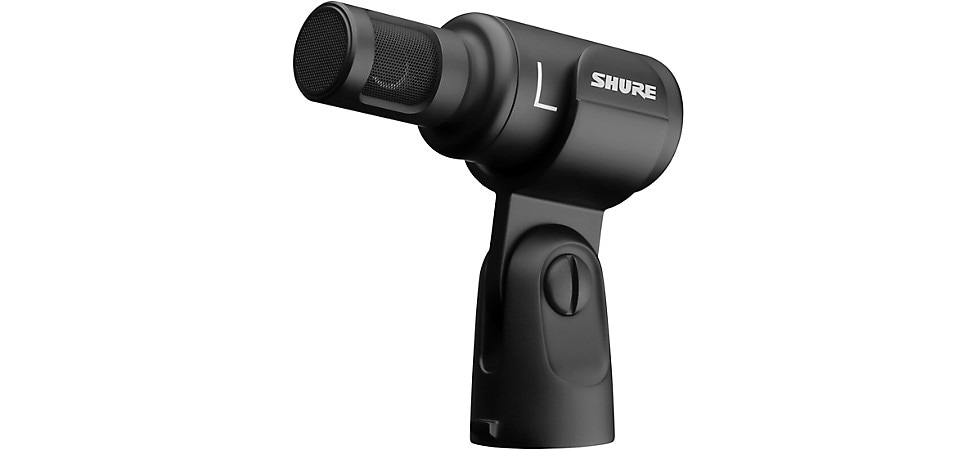
Shop Now: Shure MV88+ Stereo USB Microphone
The Shure MV88+ stereo USB mic is compatible with mobile devices via a USB-C or USB-A connector (both included). Its clever design looks great and allows for easy swiveling. Perhaps the best reason to buy this mic is the ShurePlus MOTIV mobile and desktop apps, with intuitive controls and built-in presets. Also available is the MV88+ Video Kit, which includes a Manfrotto PIXI mini tripod, phone clamp and other accessories to streamline your podcasting workflow.
DJI Mic 2
Why We Chose It: If you’re looking for an ultraportable two-lav-mic setup with cutting-edge perks like background noise canceling, this is a fine choice for capturing professional-sounding vocals with your smartphone.
Key Features:
- Each lavalier mic boasts an impressive 8GB of internal recording storage—up to 14 hours of 48kHz/24-bit audio
- Remarkable 820-foot wireless range via 2.4GHz transmission
- All-in-one bundle includes charging case, cables, magnetic clips and windscreens
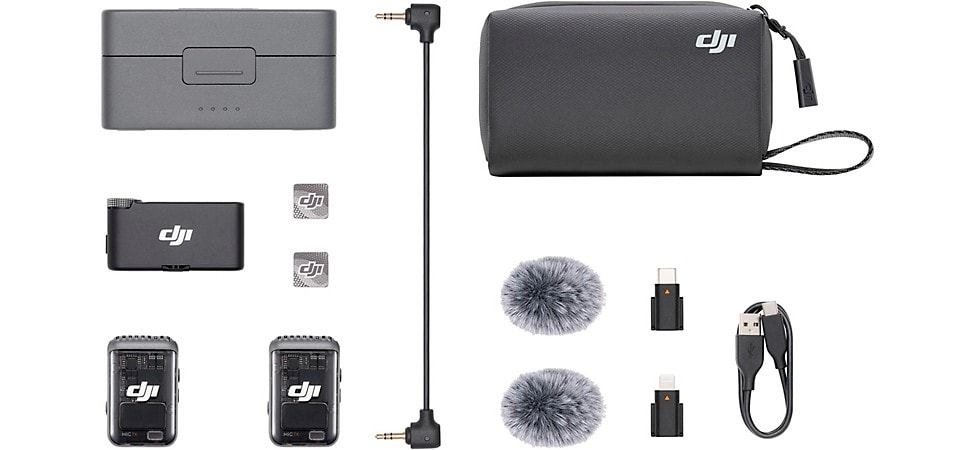
Shop Now: DJI Mic 2 Compact Digital Wireless Microphone System
Among the tiniest wireless mic systems in the world, the deceptively cute DJI Mic 2 2-person compact digital wireless mic system packs a serious punch. Each clip-on mic wirelessly transmits directly to a single receiver controlled via a 1.1" OLED touchscreen, and the entire system fits in a pocket-sized battery case capable of providing a whopping 18 hours of runtime.
Audio Interface
If you’re recording your podcast with analog microphones, you’ll need an audio interface. Interfaces take in your analog mic signal via XLR input, then output that sound in digital form via USB. They range in complexity and size. They generally work with proprietary and third-party software, digital audio workstations, that let you manage the audio easily on your computer—we’ll get to those later. Be sure to check out How to Choose the Best Audio Interface and our guide to The Best Audio Interfaces for an even deeper dive.
Focusrite Scarlett 2i2 4th Gen
Why We Chose It: This is an accessible go-to for studios of all types—its streamlined design makes it easy for even gear-newbie content creators to jump right into production.
Key Features:
- One dedicated headphone output with volume control—a headphone splitter could help in a pinch
- Auto Gain and Clip Safe take the guesswork out of setting your gain level
- Includes a comprehensive software suite, featuring Auto-Tune Access pitch correction, Relax LX480 Essentials reverb and more
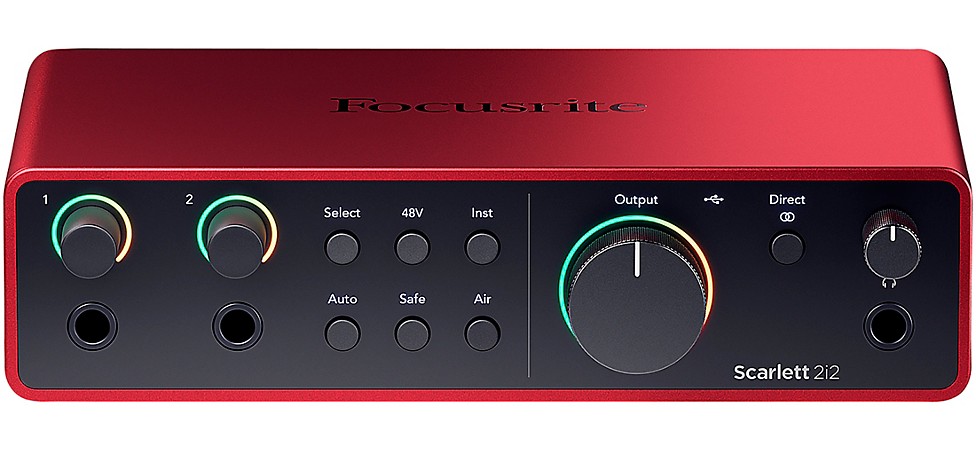
Shop Now: Focusrite Scarlett 2i2 Gen 4
The Focusrite Scarlett has been a longtime best-selling audio interface series for its affordability, reliability and simplicity. The Scarlett 2i2 4th Gen USB-C interface is ideal if you plan to record yourself and a guest while using up minimal desktop real estate. Should you need more inputs, the Scarlett 4i4 lets you plug up to four XLR mics into a slightly larger compact chassis.
PreSonus Quantum ES 2
Why We Chose It: Its sleek design, MAX-HD mic preamps and Auto Gain functionality make this a strong contender for a podcast studio centerpiece.
Key Features:
- Like the Scarlett 2i2, it has a single headphone jack and two XLR ins
- If you need more I/O (inputs and outputs) Quantum ES 4 has four mic ins and two headphone jacks
- Six-month subscription of Studio One Pro+ (full, perpetual access to Studio One included)

Shop Now: PreSonus Quantum ES 2 Audio Interface
The PreSonus Quantum ES 2 is another affordable, no-frills option. Like the Scarlett 2i2, it features two combo XLR/1/4" TRS inputs and two line outs. This interface is paired with PreSonus Studio One software, but it's compatible with recording software from third parties as well.
Universal Audio Apollo Twin X
Why We Chose It: If you’re looking for a more refined workflow with bells-and-whistles processing, Apollo Twin X combines with LUNA to emulate a full-size professional studio.
Key Features:
- Price reflects high-end components and UA software compatibility
- Desktop-friendly form factor featuring a multipurpose level/gain knob
- The difference between the DUO and QUAD is the processor—the QUAD can handle more software plug-ins at once
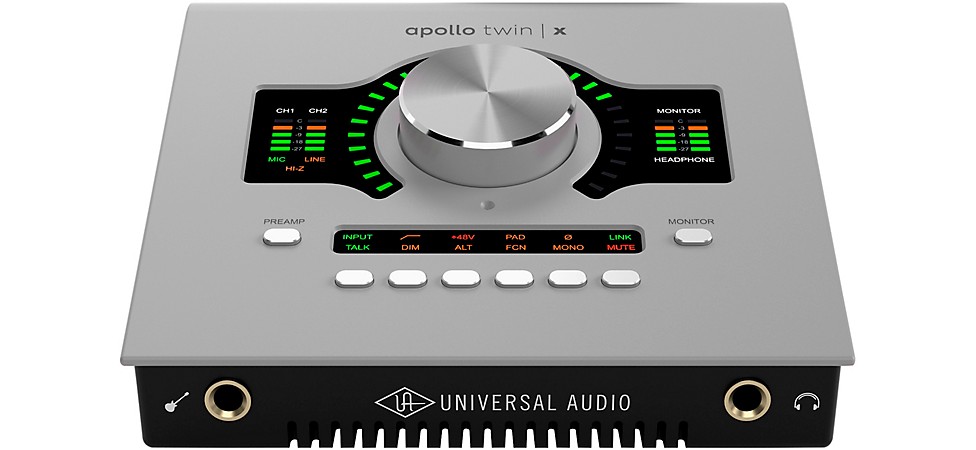
Shop Now: Universal Audio Apollo Twin X DUO Gen 2 Audio Interface
The Universal Audio Apollo Twin X DUO and QUAD interfaces connect to your PC or Mac via USB-C/Thunderbolt 3. They feature two analog mic inputs with preamps, plus outputs for monitoring and a line out for monitor speakers. But perhaps the biggest benefit of UA interfaces is that they work with the LUNA software workstation. With this intuitive software, users can access a massive library of UAD plug-ins. For podcasts, this allows you to add detailed, real-time vocal effects.
Solid State Logic SSL 2 and 2+ MKII
Why We Chose It: Both have Legacy 4K toggles that emulate the sound of SSL's famous 4000 series consoles—in a compact desktop form factor.
Key Features:
- Capture up to 32-bit/192kHz audio
- SSL 2 has a stereo line out for monitors and another for headphones
- SSL 2+ doubles the outputs, which lets you adjust two separate headphone mixes simultaneously
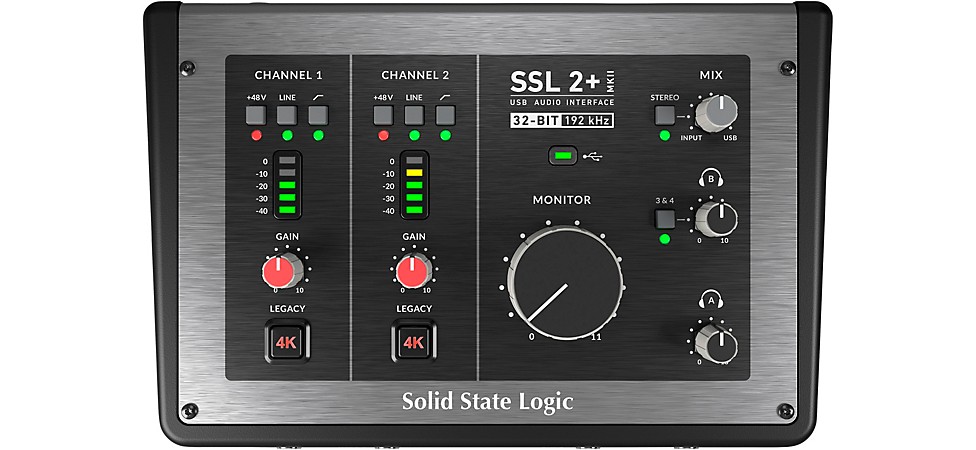
Shop Now: Solid State Logic SSL 2+ MKII USB Audio Interface
Solid State Logic is an English company known for making high-end consoles for some of the most prestigious recording studios in the world. Podcasters can benefit from that know-how with the more accessible SSL 2 MKII and SSL 2+ MKII audio interfaces. The included SSL Production software pack has the Vocalstrip 2 plug-in, which enhances dialogue recordings.
Mixers
The above interfaces can handle a couple mics on their own, but if your podcast requires more audio sources, you might need a mixer. Mixers can take many more channels and combine them into one analog signal, which then plugs into the interface. Mixers feature physical controls that let you adjust each input in detail, without software. Mixers become essential if your podcast will feature live musical performance or a large number of hosts. Some mixers also have a USB output, meaning they can double as an audio interface. If you are using analog mics, USB mixers give you adjustment and convenience in one package.
Mackie DLZ Creator Adaptive Digital Mixer for Podcasting and Streaming
Why We Chose It: With its substantial touchscreen and I/O capability, this podcasting- and streaming-specific mixer gives you everything you’ll need for even complex sessions.
Key Features:
- Four high-performance Onyx80 mic preamps
- Functions in three adaptive modes depending on technical skill level: Easy, Enhanced and Pro
- A more compact and affordable two-preamp mixer is available in the Mackie DLZ Creator XS
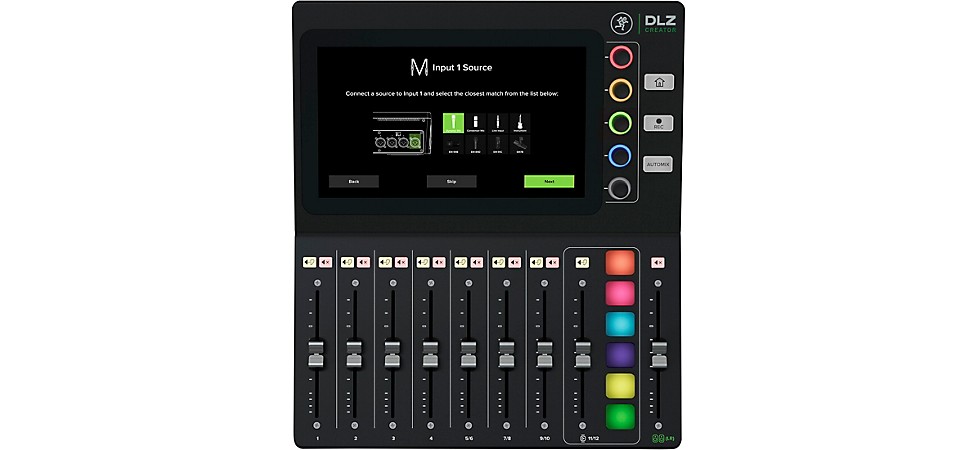
Shop Now: Mackie DLZ Creator Adaptive Digital Mixer for Podcasting and Streaming
Hosting up to 12 channels, the Mackie DLZ Creator boasts some modern conveniences like a touchscreen interface and a virtual assistant in Mix Agent technology. It features four analog mic inputs with Onyx80 preamps, as well as options to plug in from external preamps and other interfaces. Its USB-C output can go directly into your computer for streaming and/or recording, or you can record fully standalone to an SD card.
Mackie ProFX10v3
Why We Chose It: With more of an old-school channel strip format, this I/O-capable interface is perfect for those who are menu-diving averse.
Key Features:
- Four mic pres with up to ten channels
- Includes free versions of Pro Tools and Waveform OEM software
- Onboard GigFX engine gives you 24 built-in effects for adding the finishing touch to your recordings
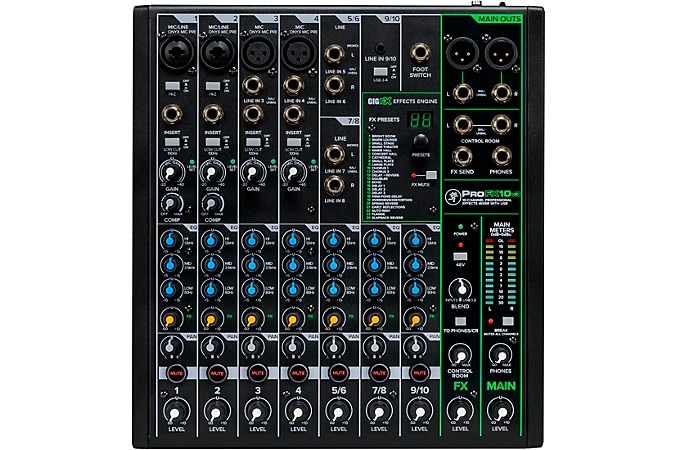
Shop Now: Mackie DLZ Creator Adaptive Digital Mixer for Podcasting and Streaming
While it’s arguably geared more toward live sound engineers, the Mackie ProFX10v3 is another hybrid USB interface/mixer that’s great for more demanding podcasts. It includes four analog mic inputs with Onyx preamps, plus an array of line inputs that work for instruments and other audio sources.
Yamaha MG10
Why We Chose It: Hailing from a legendary live mixer brand, Yamaha’s MG10 is a no-frills mixer with some serious I/O for podcasting.
Key Features:
- Compact and rugged, designed to handle the road
- No-nonsense design means no onboard effects in this case
- 3-band EQ on the four mic pre channels, 2-band on the rest
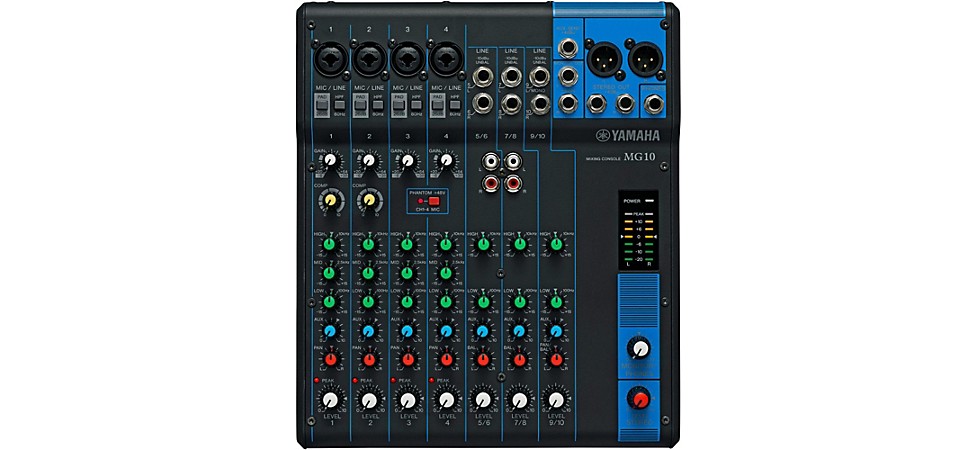
Shop Now: Yamaha MG10 10-Channel Mixer
Like the Mackie above, the Yamaha MG10 is a more traditional 10-channel mixer with analog outputs, hosting four mic inputs with additional line inputs for instruments and other sources. The preamps are built with the D-PRE inverted Darlington circuit, especially suited to vocals.
Podcast Bundles
If you’re excited to start recording and want to minimize the time you spend shopping for gear, we recommend podcasting equipment bundles as a quick, easy way to get your podcast started with a single purchase. If your show will consist of one or more people speaking in a fixed place, these all-in-one podcast recording packs can be your one-stop shop.
Each of these bundles includes some combination of microphones, audio interfaces/mixers, headphones, cables, mic stands and other accessories. We have choices geared toward beginners and pros alike, so make sure to explore these options.
RØDE RØDECaster Pro II Shure SM7B Solo Podcasting Kit
Why We Chose It: Simply put, this bundle is the premium solution for an all-in-one podcasting setup.
Key Features:
- RØDECaster Pro II mixer is one of the premier podcast-specific mixers on the market and is also available in white
- While this bundle comes with one SM7B, the mixer allows for up to four XLR mics and four headphones
- 76dB of gain offers plenty of juice for the low-output SM7B
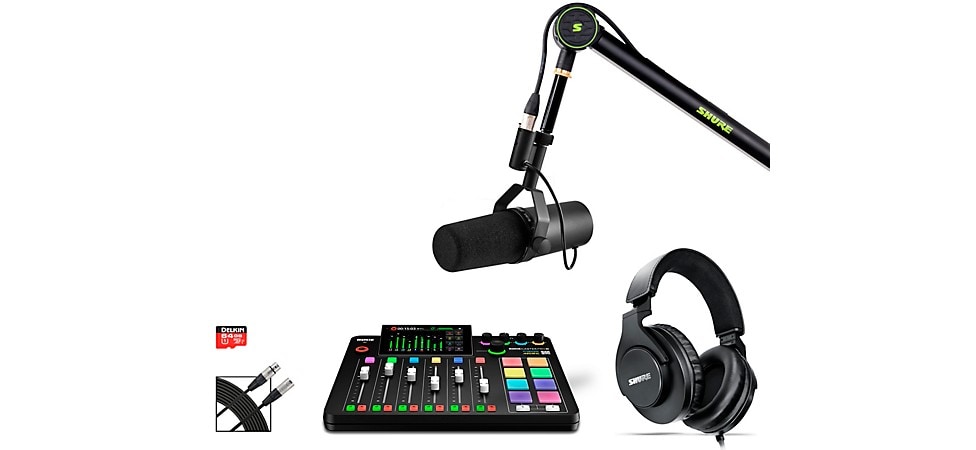
Shop Now: Shure/Rode Rodecaster Pro II and SM7B Solo Podcasting Kit
For podcasters who want a totally integrated solution, this complete RØDE/Shure podcasting bundle has everything you need for a professional-sounding podcast right out of the box. It includes a RØDECaster Pro II mixer, industry-standard Shure SM7B XLR mic, set of SRH440A headphones, a deluxe desktop mic stand, XLR cable and Delkin 64GB microSD card for immediate storage. Unbox it, set it up and you’re ready to record in minutes.
Shure SM7B Microphone and Focusrite Scarlett 2i2 Interface Podcasting Kit
Why We Chose It: This bundle combines two industry-standard mainstays, the SM7B and the Scarlett 2i2—plus a desktop boom stand, Cloudlifter and cables.
Key Features:
- Bundled Cloudlifter CL-1 boosts your signal by up to 25dB—excellent for the low-output SM7B
- Shure deluxe articulating desktop mic boom stand gives you easy position and angle adjustment
- Two XLR cable lengths included
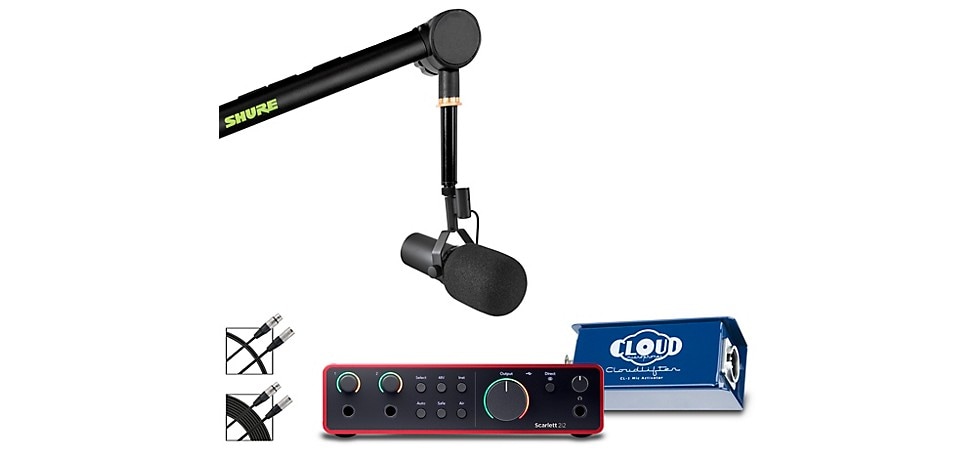
Shop Now: Shure SM7B and Focusrite Scarlett 2i2 Gen 4 Podcasting Kit
If you’ve read this far, you’re well aware of the massively popular SM7B and 2i2. Why not get both—plus some handy accessories—in one go with the Shure SM7B and Focusrite Scarlett 2i2 podcasting kit.
Headphones
Most podcasters use studio headphones to monitor their audio while they record. Closed-back models are the most common choice, since they help isolate your audio feed from outside sounds. Best-sellers from top brands include the Audio-Technica ATH-M20x, Sony MDR-7506 and Sennheiser HD 280 Pro.
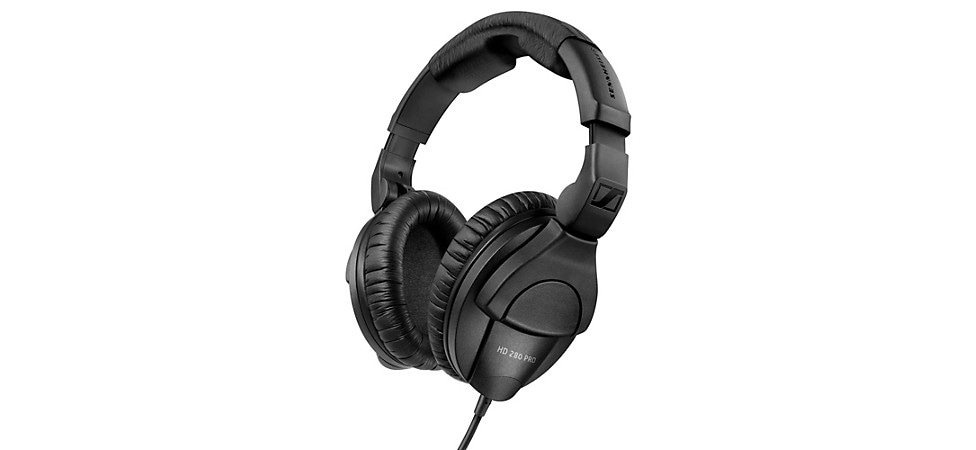
Shop Now: Sennehiser HD 280 Pro Closed-Back Headphones
Digital Audio Workstation (DAW) Software
Before the invention of computers and recording software, radio stations needed a large mixing console and tape machine to record audio. A DAW is a computer-based tape machine and mixing board that replaces all that machinery. All DAWs act as your control center for your podcast and generally serve the same basic functions. DAWs give you the tools you need to record multiple audio tracks. And just like a hardware mixing board, a DAW allows you to adjust the levels of your tracks so they sound right together. DAWs also let you use mixing tools, including EQ (equalization and sculpting of sound frequencies), compression (the evening out of volume dynamics), and spatial effects like reverb and delay (echo).
There are plenty of free options out there—Apple GarageBand, Avid Pro Tools Intro, Ableton Live Lite and many more. These DAWs will familiarize you with all the basic tools and functions of their premium counterparts. The full-featured versions of these are Logic Pro, Avid Pro Tools and Ableton 12. We cover them in detail in the DAW section of our home recording guide.
Other popular choices include PreSonus Studio One, Steinberg Cubase, FL Studio and Propellerhead’s Reason. Check out our guide on the best DAWs for beginners.
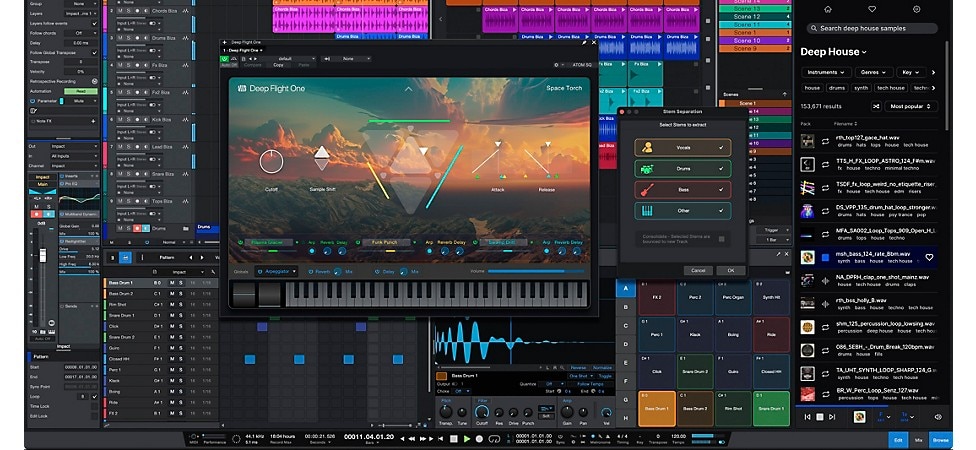
Shop Now: PreSonus Studio One Pro 7 DAW
Accessories
Many microphones come with the necessary cables, stands, shockmounts and pop filters included. Others require you to buy these accessories separately. Whichever mic you choose, make sure you have everything you need.
Cables
USB mics generally come with a short USB cable, but analog mics use an XLR cable to connect to a mixer or audio interface. Make sure to measure your space. Plan where you want to put your mics, your mixer and/or interface and your computer. Choose cable lengths accordingly.
Microphone Stands
Tabletop microphone stands are technically optional, but once you’ve recorded an hour of conversation with mic in hand, you might not feel that way. Besides, no one wants to listen to handling noise. Consider a mic stand like the Hamilton Nu-Era Tabletop. Or, if you want to keep the stand out of the way, there are adjustable boom arms like the RØDE PSA1.
Shockmounts
Table noise can be a huge annoyance for podcasters and their listeners. You don’t want your audience to hear a low-end “thud!” every time you put down your water bottle. Eliminate that problem with a shockmount, like this one from Sabra-Som.
Pop Filters
The pop filter is a simple screen with an extremely important purpose. Microphones can be vulnerable to plosives, which are consonant sounds—like “p”—that emit a sharp puff of air from your mouth. Some mics have built-in pop filters, but you should still consider the added protection of an external filter. Popular options include the Proline PPF501 and Stedman Proscreen XL.
And We're Live
We hope this guide helps you figure out exactly what gear you need to make your podcast ideas into a reality. But remember, recording equipment is only a tool. The purpose of your podcasting rig is to get out of your way so you can build a genuine connection with your audience. Never let your gear become cumbersome—keep your eye on what really matters, and come back to this guide if you ever need help.
If you need personalized help, our expert Gear Advisers are at the ready to assist with all your podcasting setup essentials. Better yet, step into a Guitar Center store near you, where our associates will be happy to find what you need to get your show live.
People Also Ask ...
How do I create a home studio for podcasting?
If you’re recording your podcast at home, the acoustics are often less than ideal. You can improve that situation with acoustic treatment products. These items are designed to capture stray sounds and prevent ambient noise. Auralex makes an industry-standard foam material you can add to walls to create isolated studio sound. If you want to leave your walls alone, there are also shields and reflectors like the Sterling Audio VMS (Vocal Microphone Shield). The VMS uses foam ribs and perforations to absorb and dissipate your vocal sounds before they can echo. For podcasters with children, roommates or pets, consider a larger sound barrier to protect your home studio from outside noise.
If you’re looking to record live musical performances, your needs may be greater. Check out our in-depth guide on home recording essentials for more.
Should I add video to my podcast?
Podcasting began as an audio format, but video podcasts have grown more popular in recent years. Many podcasts release episodes in both mediums. This allows access to YouTube, Facebook and other video-first platforms. Video can be especially useful for podcasts with musical guests, as it opens up new dimensions of showmanship. And even if the podcast is talk-based, video brings more intimacy. Filming your episodes can even be a method for making money—video is an attractive feature to put behind a paywall via Patreon or another subscription platform.
Guitar Center has a diverse selection of video production equipment that works well for podcasts. One best-selling option is the Zoom Q2n-4K video recorder, which doubles as a crisp audio recorder as well. This compact device is a great all-in-one choice for recording a video podcast on the go. In a home studio environment, the built-in mic can serve as a backup audio source in addition to your dedicated microphones.
How can I incorporate field recording into my podcast?
While smartphone mics can do in a pinch (or on a budget), there are also fully functional mobile recorders made specifically to capture sound on the go. One popular example from the industry leader in portable recorders is the Zoom PodTrak P4. This handheld recorder is as close as you can get to holding a podcast studio in your hand. It features four XLR ins, preamps, channels and headphone outputs. An LCD screen and podcast-friendly interface keep it all together.
.jpeg)







